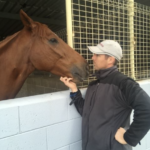Caring for thoroughbred horses involves providing proper nutrition, exercise, and health care to ensure their well-being and optimal performance. Here are some key considerations for each aspect of their care:
Nutrition
Thoroughbred horses require a well-balanced diet that provides all the necessary nutrients to support their growth and performance. A diet based on good quality hay or pasture supplemented with grain or concentrates is typically recommended. The feeding plan will depend on the horse’s age, weight, and activity level.
It’s important to ensure that horses access fresh, clean water. Additionally, providing salt blocks or supplements can help ensure that they get enough sodium and other minerals.
Exercise
Thoroughbreds are known for their athleticism and speed, and regular exercise is essential to maintaining their fitness and conditioning. Horses should be exercised daily, with a mix of low-intensity work like walking and higher-intensity work like galloping or jumping.
It’s important to gradually build up a horse’s exercise program to prevent injuries and allow their muscles and bones to adapt to their training demands. A qualified trainer or exercise rider can help develop an appropriate exercise program for a particular horse.
Some good exercises for thoroughbreds may include:
- Long, slow-distance (LSD) work involves trotting and cantering at a lower intensity for extended periods. This can help build the horse’s endurance and cardiovascular fitness.
- Interval training involves alternating periods of high-intensity work, such as galloping, with periods of rest or lower-intensity work. This can help improve the horse’s speed and overall fitness.
- Hill work training incorporates hills into a horse’s exercise routine and can help build their strength, especially in their hindquarters. This can be done by riding up and down hills or by incorporating hill work into lunging or longeing sessions.
- Setting up poles on the ground in various patterns can help improve a horse’s balance, coordination, and agility.
- If the horse is trained for it, jumping can help improve its strength, coordination, and overall athleticism.
It’s essential to keep in mind that every horse is different, and their exercise regimen should be tailored to their individual needs and abilities. It’s always a good idea to work with a qualified trainer or instructor to develop a safe and effective exercise program for your thoroughbred.
Health
Thoroughbreds are prone to specific health issues like respiratory, joint, and digestive problems. Regular veterinary check-ups can help identify and treat these issues before they become more serious. Additionally, maintaining good hygiene and sanitation practices can help prevent the spread of diseases and parasites. This includes keeping stables and equipment clean and disinfected and providing appropriate vaccinations and parasite control.
In conclusion, caring for thoroughbred horses requires attention to their nutrition, exercise, and health needs. By providing a well-balanced diet, regular exercise, and appropriate health care, owners and trainers can help ensure the well-being and success of these remarkable animals.




